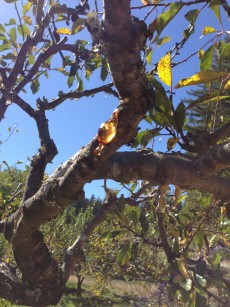I love it when a nice reader takes the time to call me to suggest a topic they?d like to see me write about or remind them what needs to be done at a certain time of year. Take Helen, who lives in Spring Lakes in Scotts Valley, for instance. Helen told me she grows tomatoes in the summer and has 4 fruit trees including a satsuma plum, an espaliered apple and a tangerine. Helen battles peach leaf curl on her plum and coddling moth larvae inside her apples and would like to know exactly what to use and when to control these problems. So this column is for you, Helen.

I know we?ve had a lot of rain which makes gardening and spraying difficult. You can prevent or control many diseases and overwintering insects by applying a dormant spray this month. This can be the most effective spray of the season. Fungal diseases such as peach leaf curl, fire blight, scab and anthracnose as well as insects including aphids, San Jose scale, bud moth, leaf roller, whitefly larvae, mealybugs and mites can all be controlled.
There are several types of dormant sprays and all three types are considered organic. Lime-Sulfur or copper can be mixed with horticultural oil which smothers overwintering insects and eggs. This spray is good for all fruit trees except apricots which should be sprayed in the fall with copper and this month only with horticultural oil.
Apply dormant spray when the temperature is above 40 degrees. Make sure you cover every nook and cranny of each branch and trunk until the tree is dripping and spray the surrounding soil. Spray only plants that have suffered from pests or disease. Sprays, even organic, can kill beneficial insects as well. Even though they?re organic, dormant sprays can be irritating to skin and eyes, Wear long sleeves and gloves and eye protection.
Spinosad has been shown to suppress fungal diseases. Do this when the buds swell but before they open. Do not spray 36 hours before rain in predicted. Be sure to spray the ground around each tree.
Coddling moth control requires a different approach. The larvae of this particular moth is one of the few caterpillars that are likely to be found inside pear or apples. University of California Integrated Pest Management website has complete information about controlling this pest.
The website is http://ipm.ucanr.edu/PMG/PESTNOTES/pn7412.html
The bottom line for coddling moth control is the timing of insecticide spray applications, especially with newer, less toxic pesticides like spinosad. The coddling moth overwinters as full grown larvae within thick silken cocoons under loose scales of bark and in soil or debris around the base of the tree. The larvae emerge as adult moths mid-March to early April. To be effective your spray application must be timed for when when they are active.
Starting three to four weeks after bloom, check fruit at least twice a week looking for the first ?stings? or any mounds of reddish-brown frass. If you scrape the frass away you will see the tiny entry hole where the newly hatched larvae has just entered the fruit. Spray the tree as soon as you see the first sting after removing any fruit with stings as the insecticide won?t kill any larvae that have already entered the fruit. Coddling moths can have three or four generations per year.
According to the website, for most backyard situations, the best course of action might be to combine a variety of non chemical methods and accept the presence of some wormy fruit. Be sure to cut out the damaged portions because they might contain toxins generated by mold.
Oh and by the way, Helen told me she is 88 years young so if Helen can do it, you can too.


